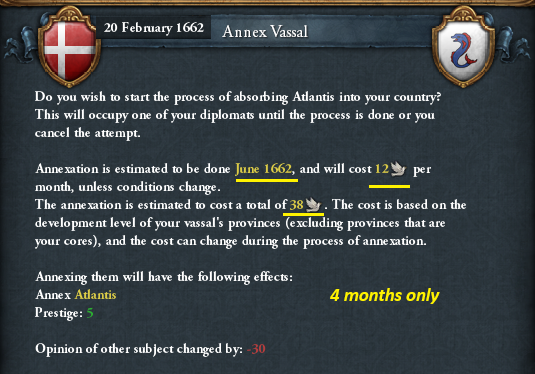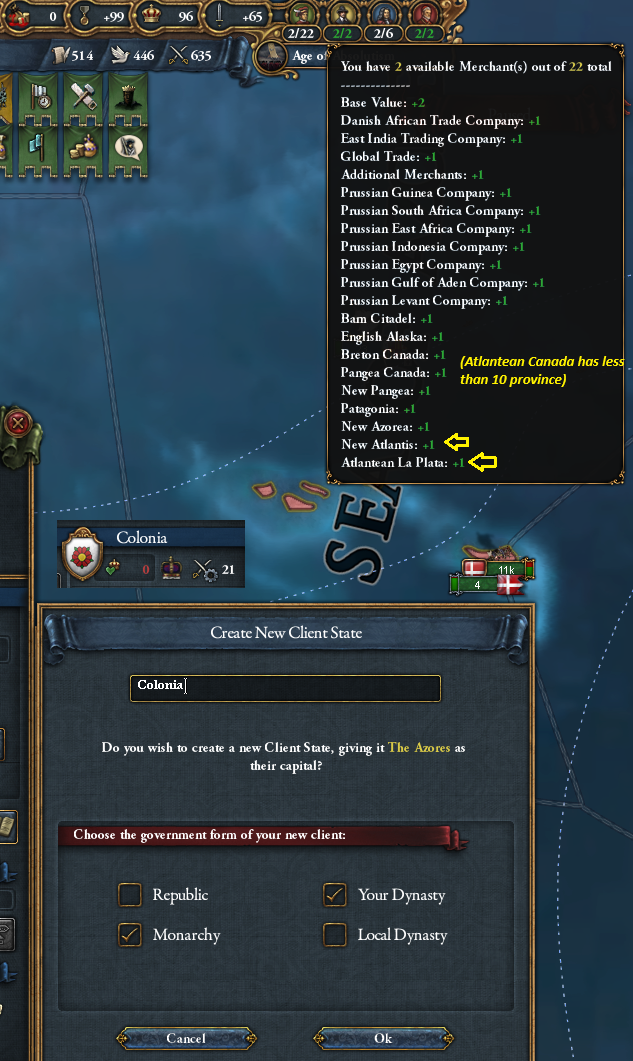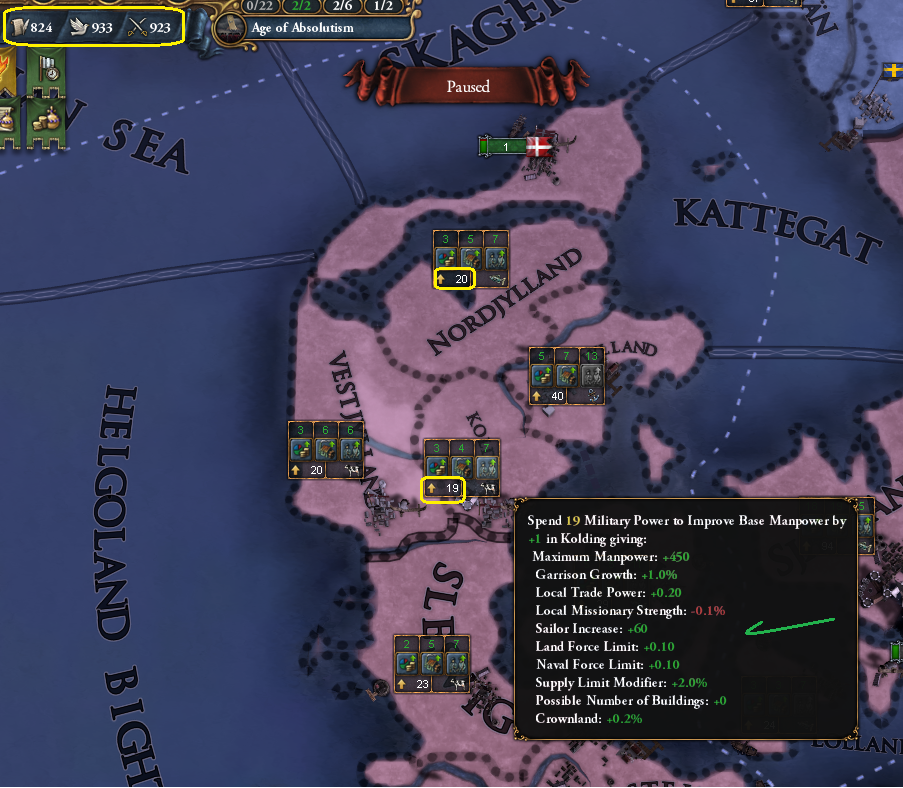Chapter 23: Studying Harder(1660-1670)
The highlight of the last chapter was the use of the Kyoto Imperial City as a University of sorts to educate Emperor Christian. We ended the decade at war with Gurkani . Allied to Gurkani were Adal and Kilwa. And Adal was the first nation to peace out

Provinces that were Oromo were fed directly to Sheba, avoiding the annexation of any Somali land. The Somali land will be eventually (in the 1700s) given to Sheba, but not before Sheba is expanded outside her culture group, primarily into Arabia and the Levantine group.
Next was Kilwa who lost provinces to both Sheba and Sudafrica based on culture

Then Gurkani was ready for a comprehensive peace in February 1662. Now, initially, the aim of the war was to grow Bactria more into the Indian heartland, specifically the Punjabi culture lands that Bactria accepted. But due to technical reasons [see footnote], it was decided that the coastal provinces that Denmark could annex directly were a better option . And Bactria found herself expanding on the Arabian side of the Persian Gulf, into Khaleeji and Omani culture land.

And as a result of this, the Emperor decided on a tentative plan for future governance of the Levantine people, to be split among neighboring client states that would accept their cultures, and thus avoid needing a designated Levantine client state.
With the Gurkani treaty, Denmark was at peace again. And that allowed her to do two things. First, Atlantis was diplomatically annexed.

When that completed in a few months, Denmark became the new direct overlord of Atlantean La Plata, Atlantean Canada and New Atlantis. And following in the tradition of Pangea, Azorea and Atlantis, a new nation called Colonia was created out of the Azores

THe second peace-time action performed was the sale of Kyoto. But this time not to Japan. Rather it was sold to the original owner Ashikaga, for the fire sale price of 75 ducats.

Ashikaga had apparently survived as a one province minor on the Southern Island of Kyushu thanks to occasional alliances or guarantees by Asian powers like the Later Jin . And they still held on to their core on Kyoto (among others), and so were guaranteed to agree to buy it as long as the price was right . More importantly, the sale did not trigger a truce between Denmark and Ashikaga. And that meant that as soon as Denmark had a claim fabricated on Kyoto, war could be declared to take the city back:

Less than a year later, Ashikaga was forced to cede Kyoto back to Denmark . And the Imperial City was upgraded again, with Christian IV making his 3rd pilgrimage to the site, earning him more diplomatic skills ( his administrative and military skills were already perfected)

By doing that, Christian IV now matched the exact skill level of his illustrious predecessor Christian I the Great . But as he boarded the ship back to Denmark, he ordered the sale of Kyoto back to Japan this time. And he told the gathered Sensei that he would return for more "studies" sometime after the truce with Japan expired in December 1644.

Upon his return to ZEeland, Emperor Christian "the Educated", as he was becoming known, ordered a fresh set of wars, against Canada in NOrth America, Aachen in Europe, and Vijayanagar in India.

The easiest war and the first to finish was Canada. Annexed lands were partitioned among the various colonial nations, trying, as much as possible, to keep similar native culture provinces in one colonial nation ( to hopefully incentivize the CN to accept them ) .

This was made difficult by the haphazard distribution of the various cultures due to past native tribe migrations ( note that the majority of the provinces were Prussian from the days when Vinland and Atwixia ruled all these lands).
The second easiest war was in Europe where the Personal Union armies helped Danish siege stacks quickly conque the enemy forts and capitals. Cologne was first to cede land.

MEanwhile the truce with Japan expired, and a fresh war for Kyoto was started.

Back in Europe, Saxony lost some more German provinces to Denmark.

And then a while later all of Goslar, Lorraine and Aachen were absorbed into Denmark's growing home region.

While the Aachener war was wrapping up, the war in Japan had completed and Tokyo was taken back for the 4th time.

And just like Emperor Christian had promised, he returned to complete his personal education and reached the sublime ranking of 6/6/6 , normally the domain of Republican leaders and the rare exceptional monarch. But now with Denmark's wealth and the availability of the Imperial City, such skills should be within reach of all his successors [this is actually better than Republics because you can have a young heir take over by abdication in his 20s and stats are likely to be better than a new Consul's 4/1/1] .
The last peace treaty of the current war chain was with Vijayanagar, who lost much of their coastline. The annexed provinces went mainly to India and the new Client State of Saurashtra ( named after the historical Kingdom of Syrastrene and the local culture).

As has become customary, culture lines were followed closely . The new client state was created as the Emperor estimated that India alone would not be able to rule the entire subcontinent with accepted cultures, and would become too big and potentially rebellious as a result. So sharing the load with a new Client State seemed prudent. Saurashtra would be wedged between Bactria to the West, and India to its East and would be destined to expand toward the Gangetic plain and in the West Aryan culture group.
And with Denmark at peace, Tokyo was "sold" again to Ashikaga for zero ducats.

It was now time for another batch of wars . And the Emperor chose Taungu who was allied to Ava and a couple of minor states in Indochina.

Although Denmark could have obtained a claim on them, the Emperor eschewed that to save time, realizing that a no casus belli war now made no difference to Denmark who could easily handle the war exhaustion and aggressive expansion hits. (there is no stability hit from Diplomatic Idea group and Government Reform Tier 9 )
And while that war raged, the Emperor visited the old lands of Denmark proper and spent some of the accumulating monarch power on developing them for manpower and production .

Although Denmark had no lack of manpower to wage her wars ( and could still rely on mercenaries, who were not being disbanded any more in peacetime as the treasury had become a bottomless source of money), the Emperor was keen on keeping Denmark relatively more powerful than her Client States in order to keep their liberty desire in check . And having highly developed home provinces [playing tall] produced compound benefits thanks to the many buildings constructed there .
the war in Indochina was quickly wrapped up in 1669.




A few provinces went to Malay and Eastasia. But the lion's share of the annexation went to the new Client State of Burma, created out of what used to be Ava with its capital at Taungoo. Burma was to serve a similar role to Saurashtra, and grow into Southern China to take some load off of Eastasia .
With that out of the way, war was resumed again. This time against Ayutthaya to consolidate Indochina, with a side war on Bregenz in Europe to consolidate Germany.

And when the truce with Ashikaga expired in July 1669, another quick war for Kyoto was undertaken , re-annexing the city in late 1669.

Because Denmark had an overflow of monarch power, the Emperor decided to hold off on completing the upgrade of Kyoto for the time being ( and this time he was not going to attend the upgrade in person as his "education" had been completed [we now get 100 ADM 100 DIP and 100 MIL ]).
And that brings us to the end of the decade.

Denmark is filthy rich in Gold, and has excess administrative, diplomatic and military power thanks to Kyoto's Imperial City.
The only challenges facing the Wittelsbach plan for world domination now are patience and the liberty desire of Denmark's many subjects.
Footnote:
when annexing from enemy nations, Denmark can get a lot more directly as opposed to having the enemy cede to a vassal via transfer occupation. This is because vassal's administrative efficiency is lower than Denmark's ( less absolutism and they do not have discounts like Malta Forts). But there is a limitation that Denmark can only annex what she can core. This restriction will be lifted in Age of Revolutions with the "Unrestricted Conquest" ability . So I am saving inland provinces which Denmark cannot core directly till then.
The highlight of the last chapter was the use of the Kyoto Imperial City as a University of sorts to educate Emperor Christian. We ended the decade at war with Gurkani . Allied to Gurkani were Adal and Kilwa. And Adal was the first nation to peace out

Provinces that were Oromo were fed directly to Sheba, avoiding the annexation of any Somali land. The Somali land will be eventually (in the 1700s) given to Sheba, but not before Sheba is expanded outside her culture group, primarily into Arabia and the Levantine group.
Next was Kilwa who lost provinces to both Sheba and Sudafrica based on culture

Then Gurkani was ready for a comprehensive peace in February 1662. Now, initially, the aim of the war was to grow Bactria more into the Indian heartland, specifically the Punjabi culture lands that Bactria accepted. But due to technical reasons [see footnote], it was decided that the coastal provinces that Denmark could annex directly were a better option . And Bactria found herself expanding on the Arabian side of the Persian Gulf, into Khaleeji and Omani culture land.

And as a result of this, the Emperor decided on a tentative plan for future governance of the Levantine people, to be split among neighboring client states that would accept their cultures, and thus avoid needing a designated Levantine client state.
With the Gurkani treaty, Denmark was at peace again. And that allowed her to do two things. First, Atlantis was diplomatically annexed.

When that completed in a few months, Denmark became the new direct overlord of Atlantean La Plata, Atlantean Canada and New Atlantis. And following in the tradition of Pangea, Azorea and Atlantis, a new nation called Colonia was created out of the Azores

THe second peace-time action performed was the sale of Kyoto. But this time not to Japan. Rather it was sold to the original owner Ashikaga, for the fire sale price of 75 ducats.

Ashikaga had apparently survived as a one province minor on the Southern Island of Kyushu thanks to occasional alliances or guarantees by Asian powers like the Later Jin . And they still held on to their core on Kyoto (among others), and so were guaranteed to agree to buy it as long as the price was right . More importantly, the sale did not trigger a truce between Denmark and Ashikaga. And that meant that as soon as Denmark had a claim fabricated on Kyoto, war could be declared to take the city back:

Less than a year later, Ashikaga was forced to cede Kyoto back to Denmark . And the Imperial City was upgraded again, with Christian IV making his 3rd pilgrimage to the site, earning him more diplomatic skills ( his administrative and military skills were already perfected)

By doing that, Christian IV now matched the exact skill level of his illustrious predecessor Christian I the Great . But as he boarded the ship back to Denmark, he ordered the sale of Kyoto back to Japan this time. And he told the gathered Sensei that he would return for more "studies" sometime after the truce with Japan expired in December 1644.

Upon his return to ZEeland, Emperor Christian "the Educated", as he was becoming known, ordered a fresh set of wars, against Canada in NOrth America, Aachen in Europe, and Vijayanagar in India.

The easiest war and the first to finish was Canada. Annexed lands were partitioned among the various colonial nations, trying, as much as possible, to keep similar native culture provinces in one colonial nation ( to hopefully incentivize the CN to accept them ) .

This was made difficult by the haphazard distribution of the various cultures due to past native tribe migrations ( note that the majority of the provinces were Prussian from the days when Vinland and Atwixia ruled all these lands).
The second easiest war was in Europe where the Personal Union armies helped Danish siege stacks quickly conque the enemy forts and capitals. Cologne was first to cede land.

MEanwhile the truce with Japan expired, and a fresh war for Kyoto was started.

Back in Europe, Saxony lost some more German provinces to Denmark.

And then a while later all of Goslar, Lorraine and Aachen were absorbed into Denmark's growing home region.

While the Aachener war was wrapping up, the war in Japan had completed and Tokyo was taken back for the 4th time.

And just like Emperor Christian had promised, he returned to complete his personal education and reached the sublime ranking of 6/6/6 , normally the domain of Republican leaders and the rare exceptional monarch. But now with Denmark's wealth and the availability of the Imperial City, such skills should be within reach of all his successors [this is actually better than Republics because you can have a young heir take over by abdication in his 20s and stats are likely to be better than a new Consul's 4/1/1] .
The last peace treaty of the current war chain was with Vijayanagar, who lost much of their coastline. The annexed provinces went mainly to India and the new Client State of Saurashtra ( named after the historical Kingdom of Syrastrene and the local culture).

As has become customary, culture lines were followed closely . The new client state was created as the Emperor estimated that India alone would not be able to rule the entire subcontinent with accepted cultures, and would become too big and potentially rebellious as a result. So sharing the load with a new Client State seemed prudent. Saurashtra would be wedged between Bactria to the West, and India to its East and would be destined to expand toward the Gangetic plain and in the West Aryan culture group.
And with Denmark at peace, Tokyo was "sold" again to Ashikaga for zero ducats.

It was now time for another batch of wars . And the Emperor chose Taungu who was allied to Ava and a couple of minor states in Indochina.

Although Denmark could have obtained a claim on them, the Emperor eschewed that to save time, realizing that a no casus belli war now made no difference to Denmark who could easily handle the war exhaustion and aggressive expansion hits. (there is no stability hit from Diplomatic Idea group and Government Reform Tier 9 )
And while that war raged, the Emperor visited the old lands of Denmark proper and spent some of the accumulating monarch power on developing them for manpower and production .

Although Denmark had no lack of manpower to wage her wars ( and could still rely on mercenaries, who were not being disbanded any more in peacetime as the treasury had become a bottomless source of money), the Emperor was keen on keeping Denmark relatively more powerful than her Client States in order to keep their liberty desire in check . And having highly developed home provinces [playing tall] produced compound benefits thanks to the many buildings constructed there .
the war in Indochina was quickly wrapped up in 1669.




A few provinces went to Malay and Eastasia. But the lion's share of the annexation went to the new Client State of Burma, created out of what used to be Ava with its capital at Taungoo. Burma was to serve a similar role to Saurashtra, and grow into Southern China to take some load off of Eastasia .
With that out of the way, war was resumed again. This time against Ayutthaya to consolidate Indochina, with a side war on Bregenz in Europe to consolidate Germany.

And when the truce with Ashikaga expired in July 1669, another quick war for Kyoto was undertaken , re-annexing the city in late 1669.

Because Denmark had an overflow of monarch power, the Emperor decided to hold off on completing the upgrade of Kyoto for the time being ( and this time he was not going to attend the upgrade in person as his "education" had been completed [we now get 100 ADM 100 DIP and 100 MIL ]).
And that brings us to the end of the decade.

Denmark is filthy rich in Gold, and has excess administrative, diplomatic and military power thanks to Kyoto's Imperial City.
The only challenges facing the Wittelsbach plan for world domination now are patience and the liberty desire of Denmark's many subjects.
Footnote:
when annexing from enemy nations, Denmark can get a lot more directly as opposed to having the enemy cede to a vassal via transfer occupation. This is because vassal's administrative efficiency is lower than Denmark's ( less absolutism and they do not have discounts like Malta Forts). But there is a limitation that Denmark can only annex what she can core. This restriction will be lifted in Age of Revolutions with the "Unrestricted Conquest" ability . So I am saving inland provinces which Denmark cannot core directly till then.
- 2































